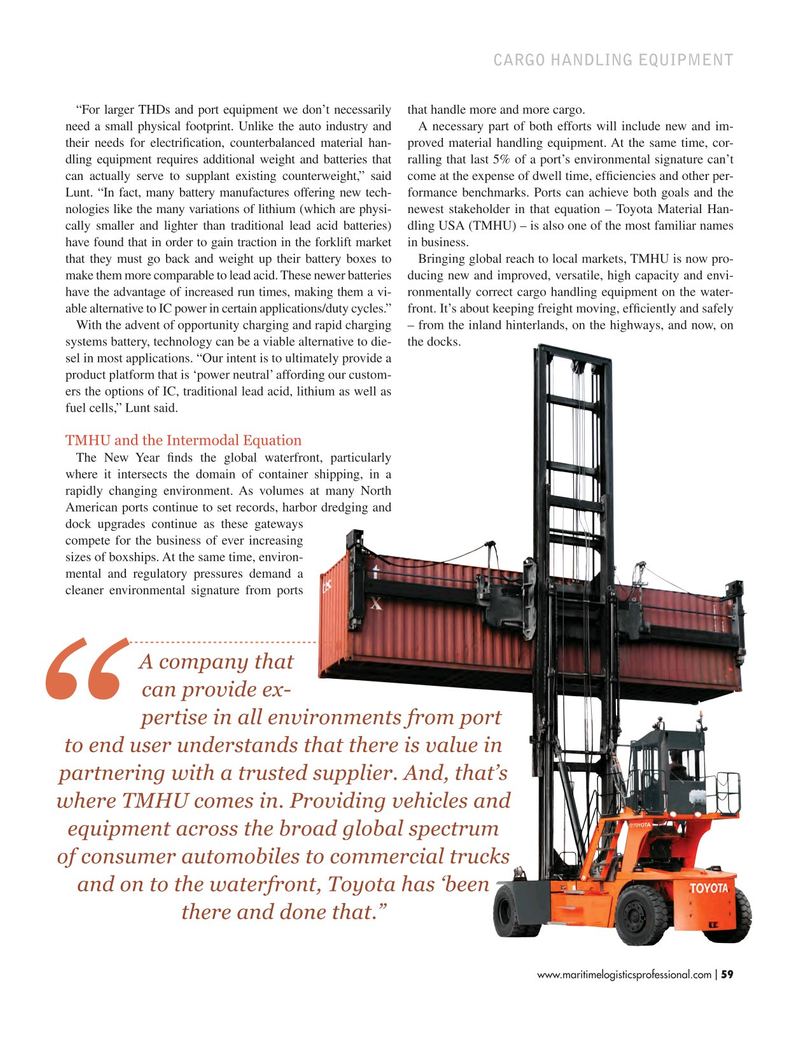
Page 59: of Maritime Logistics Professional Magazine (Nov/Dec 2017)
GREEN PORTS
Read this page in Pdf, Flash or Html5 edition of Nov/Dec 2017 Maritime Logistics Professional Magazine
CARGO HANDLING EQUIPMENT “For larger THDs and port equipment we don’t necessarily that handle more and more cargo.
need a small physical footprint. Unlike the auto industry and A necessary part of both efforts will include new and im- their needs for electrifcation, counterbalanced material han- proved material handling equipment. At the same time, cor- dling equipment requires additional weight and batteries that ralling that last 5% of a port’s environmental signature can’t can actually serve to supplant existing counterweight,” said come at the expense of dwell time, effciencies and other per-
Lunt. “In fact, many battery manufactures offering new tech- formance benchmarks. Ports can achieve both goals and the nologies like the many variations of lithium (which are physi- newest stakeholder in that equation – Toyota Material Han- cally smaller and lighter than traditional lead acid batteries) dling USA (TMHU) – is also one of the most familiar names have found that in order to gain traction in the forklift market in business.
that they must go back and weight up their battery boxes to Bringing global reach to local markets, TMHU is now pro- make them more comparable to lead acid. These newer batteries ducing new and improved, versatile, high capacity and envi- have the advantage of increased run times, making them a vi- ronmentally correct cargo handling equipment on the water- able alternative to IC power in certain applications/duty cycles.” front. It’s about keeping freight moving, effciently and safely
With the advent of opportunity charging and rapid charging – from the inland hinterlands, on the highways, and now, on systems battery, technology can be a viable alternative to die- the docks. sel in most applications. “Our intent is to ultimately provide a product platform that is ‘power neutral’ affording our custom- ers the options of IC, traditional lead acid, lithium as well as fuel cells,” Lunt said.
TMHU and the Intermodal Equation
The New Year fnds the global waterfront, particularly where it intersects the domain of container shipping, in a rapidly changing environment. As volumes at many North
American ports continue to set records, harbor dredging and dock upgrades continue as these gateways compete for the business of ever increasing sizes of boxships. At the same time, environ- mental and regulatory pressures demand a cleaner environmental signature from ports
A company that can provide ex- pertise in all environments from port to end user understands that there is value in partnering with a trusted supplier. And, that’s where TMHU comes in. Providing vehicles and equipment across the broad global spectrum of consumer automobiles to commercial trucks and on to the waterfront, Toyota has ‘been there and done that.” www.maritimelogisticsprofessional.com 59
I

 58
58

 60
60
